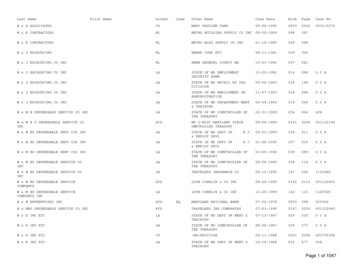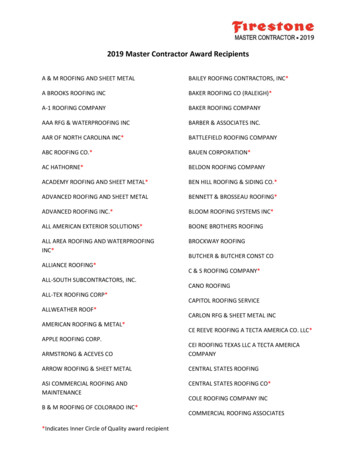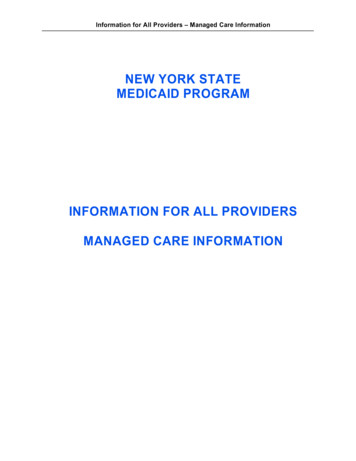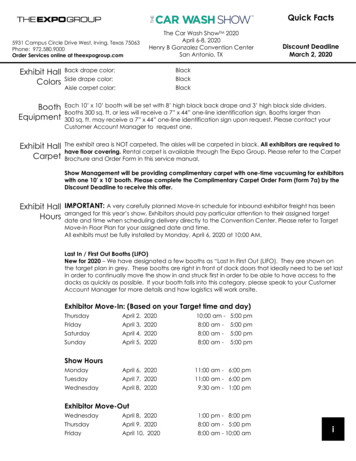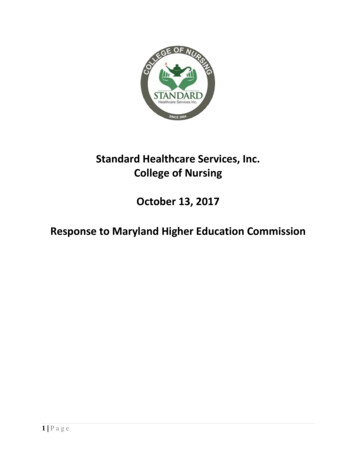
Transcription
Standard Healthcare Services, Inc.College of NursingOctober 13, 2017Response to Maryland Higher Education Commission1 Page
IntroductionPlease accept this statement from Standard Healthcare Services College of Nursing (“StandardCollege”) in response to your letter dated September 26, 2017. This response contains fiveparts: (1) the introduction, (2) the procedural history of Standard College’s application, (3) thefacts of the case, (4) a discussion pertaining to COMAR 13B.02.03.09, COMAR 13B.02.03.08, aswell as the comments raised by the letter writers, and (5) the conclusion.Standard College’s objective in seeking authorization to operate at a clinical site in a Marylandhospital is to meet the educational needs of its Maryland students.Over 40% of the students in the Standard College LPN to RN program reside in Maryland.1 TheMaryland students currently drive 1 ½ - 2½ hours one way in difficult DC/MD/VA traffic toattend a clinical practicum, a required part of the program, now located at a Virginia hospital.Standard College hopes to remedy the arduous commute of Maryland students by gainingpermission to offer a clinical practicum in Maryland.The clinical practicum in Maryland, if the application is approved, will accommodate eight-tenstudents at a time, and will run once a week for a total of 32 weeks during the year. The eightten students participating in the clinical practicum in Maryland will all be residents of Maryland.The Virginia students at Standard College will continue to attend the clinical site at a hospitallocated in Virginia.Procedural HistoryOn November 4, 2016, Standard College submitted an application for initial approval withMHEC as an Out-of-State institution seeking permission to offer an experiential learning, clinicalpracticum, at a Maryland hospital, as a required part of the curriculum for students enrolled inits LPN to RN program.2 On Nov. 10, 2016, MHEC requested four additional documents fromStandard College in order to complete the application.3 On Dec. 29, 2016, MHEC informedStandard College that the application was deemed complete. Institutions of higher educationwere subsequently informed of the proposal, and a period for comments was held. On March1Students live in numerous locations throughout Maryland, including Baltimore, Germantown, Owings Mills,Waldorf, Hyattsville, Gaithersburg, Bowie, Hyattsville, Clinton, Silver Spring, Lanham, Gwynn Oak, and Laurel.2The proposed application would place eight-ten students at a time at one site in Maryland in a supervisedpracticum.3On Nov. 10, 2016 MHEC informed Standard College that “the following is required in order to deem theapplication complete and begin the circulation process: Pg 4: New programs - Please list the information for the degree, not the practicum courses Pg 6: Comparison to existing programs in the state - this section is insufficient. You must compare theproposed program to similar programs offered in the State of Maryland and demonstrate that theproposed program is not substantially duplicative Please provide the current Certificate of Good Standing to operate in Maryland Please provide a copy of the degree(s) to be awarded.”2 Page
27, 2017, MHEC informed Standard College that “the proposal submitted by Standard hascompleted the 30-day circulation period without any comments or objections.” On the sameday, MHEC informed Standard College that a required document, a memorandum ofunderstanding, had not been included with the application and “a current signed and executedMOU is required in order to proceed with the authorization process.”4 An MOU was not one ofthe documents cited in the November 2016 request. Standard College was instructed to submita revised application, along with the written memorandum of understanding with a Marylandentity, which it did on April 28, 2017. 5 Again, MHEC accepted the application, institutions ofhigher education were informed of the proposal, and a now a second 30-day notice period wasinvoked. This time, eight community colleges, along with the Maryland Association of AssociateDegree Nursing Programs, submitted comments, objecting to Standard College’s application.FactsStandard College is a degree-granting, private nursing school, located in Falls Church, Virginia.Standard College is accredited by the Accrediting Bureau of Health Education Schools, certifiedto operate by the State Council of Higher Education in Virginia, and approved by the VirginiaBoard of Nursing. Standard College has been operating in good standing in the State of Virginiasince 2004. Standard College offers two programs: an LPN to RN program and a PracticalNursing program. The diverse, multi-cultural student population is comprised of self-directed,motivated adult learners, represented by 87% African American students, 7% Asian students, 3% Hispanics/Latino students, and 3% White/Caucasian students.6 Standard College’s studentbody composition is comparable to the student race/ethnicity profile of Historically BlackColleges in Maryland.Standard College’s LPN to RN program contains a clinical practicum requirement. Students arerequired to participate in a once per week, 12 hour shift, at a clinical site within a hospitalsetting for a sixteen-week period. Each is shift is held from 7:00 am – 7:00 pm. Currently, thestudents are participating in one of three possible clinical sites in Virginia: Sentara Hospital,located at 2300 Opitz Blvd, Woodbridge, VA 22191, Stone Spring Hospital, located at 24440Stone Springs Blvd, Dulles, VA 20166, or Dominion Hospital, located at 2960 Sleepy Hollow Rd,Falls Church, VA 22044.DiscussionYou have asked that particular attention be given to the Code of Maryland Regulations(COMAR) concerning criteria for approving proposed programs, especially unreasonableprogram duplication that would cause demonstrable harm to another institution, addressed in4On March 28, 2017, MHEC informed Standard College that “The MOU is required as a part of the application; wecannot proceed without it” and “a current signed and executed MOU is required in order to proceed with theauthorization process.”5Standard College signed an MOU with Doctor’s Hospital in July 2017 and with Heritage Care in April 2017.6The National Center for Education Statistics,https://nces.ed.gov/collegenavigator/?q Standard Healthcare Services&s all&id 483814#enrolmt3 Page
COMAR 13B.02.03.09 and also compelling regional need and demand issues as outlined inCOMAR 13B.02.03.08. You have also asked that Standard College respond to the commentsraised in the letters of objection. We will proceed with a response to each of these issues.Duplication of the Proposed ProgramAccording to the State of Maryland, evidence to substantiate whether Standard College isduplicative to similar nursing schools includes looking at existing programs in a specificgeographically proximate location in the State.7Here, this means identifying the nursing programs that are within geographic proximity toDoctor’s Hospital and Heritage Care, the proposed clinical sites for Standard College students.There are approximately 15 private and 1 public nursing school located within a 10 mile radiusto the proposed clinical sites. None of these schools raised an objection or commented onStandard College’s application during either of the two comment periods.Although eight community colleges did comment on Standard College’s application, PrinceGeorge’s Community College (PGCC), the closest nursing school to the proposed clinical site,was not among these colleges who voiced an objection or comment. PGCC is located about 9miles from Doctor’s Hospital. PGCC did not comment or object to Standard College’s applicationduring either comment period.The nursing schools that did comment to Standard College’s application during the secondcomment period, Anne Arundel Community School, Allegany College of Maryland, CarrollCommunity College, Cecil College, College of Southern Maryland, Community Colleges ofBaltimore County, Frederick Community College, Howard Community College are located 28,144, 54, 72, 37, 24, 55, and 23 miles, respectively, to Doctor’s Hospital. While MHECunderstandably provides an opportunity for nursing educational institutions to respond to anout-of-state institution application, the impact of harm to a college 50 miles away or more fromthe clinical site at Doctor’s Hospital is negligible. If, on the other hand, instead of eight, therewere eighty or eight hundred students from Standard College, this could be a cause of concern.But with only eight to ten students from Standard College participating at the Maryland siteonce per week, the suggestion of harm is questionable. Furthermore, neither the communitycolleges nor MAADNP provided data to support their contention of possible harm.Additional evidence the Commission considers when determining whether unreasonableduplication of existing programs is an “analysis of enrollment characteristics.”8 As noted7COMAR 13B.02.03.09 states that “Evidence demonstrating that a proposed program is not duplicative of similarofferings in the State shall be submitted by the institution. At a minimum, this evidence shall be substantiated on thebasis that the proposed program to be offered is not unreasonably duplicative of existing programs in a specificgeographically proximate location in the State.”8COMAR 13B02.03.09 C2(d)Determination of Duplication, Analysis of enrollment characteristics4 Page
earlier, the student body composition at Standard College consists of 87% of the student bodyidentifying as Black/African. All eight community colleges have a substantially different studentbody composition to Standard College. They are far less diverse, and for this reason, provide asignificantly different educational experience. Arguably, none of them are a duplicativeprogram to Standard College on this basis alone. Based on the National Center for EducationalStatistics, the percentage of Black/African students at the 8 objecting community colleges are:Anne Arundel Community SchoolAllegany College of MarylandCarroll Community CollegeCecil CollegeCollege of Southern MarylandCCBCFrederick Community CollegeHoward Community College17%11%4%10%26%38%12%29%Additional evidence the Commission considers when determining unreasonable duplication ofexisting programs is an analysis of the program’s “admission requirements.”9 Students who areperceived as “less competitive” and are rejected by the programs in Maryland, but who havestrong GPAs, may apply for admission to Standard College’s LPN to RN Associate degreeprogram. The students from Maryland who get accepted into Standard College are thensubsequently supported and empowered to flourish in the nursing program. They becomesuccessful students and professionals, as measured by traditional benchmarks. In the fall 2016graduating LPN to RN class, 83% of the students graduated from the program and 50% of thestudents continued their education by enrolling in a BSN program. The retention rate for the2015-2016 LPN to RN class is 93%. The five year average NCLEX rate is 89%.Compelling Regional Need and Demand IssuesThe more expansive admission requirements at Standard College dovetail with the school’sinterest in expanding educational opportunities and choices for minority and educationallydisadvantaged students at institutions of higher education. The Maryland Code of Regulationsstate that a program proposal may demonstrate demand and need for the program in terms ofmeeting present and future needs of the region and the State in general by identifying “Societalneeds, including expanding educational opportunities and choices for minority andeducationally disadvantaged students at institutions of higher education.” 10Standard College’s admission criteria supports Maryland students who have not secured,cannot secure admission, or are admitted, but chose not to attend, the nursing programs inMaryland. Students who desire to work in the nursing profession, but are unable to beadmitted in their home state, find the solution of a higher, relative short term cost of attending910COMAR 13B02.03.09 C2(f) Determination of Duplication, Admission requirementsCOMAR 13B.02.03.08.08 B(2) Need for the Proposed Program5 Page
Standard College cheaper than waiting for some future, unspecific date when they might beadmitted to the community colleges in Maryland. It is these students that Standard Collegesupports. That said, a number of students at Standard College have been admitted into one ofthe Maryland community college nursing schools. The students choose not to attend theMaryland nursing school for a variety of reasons, including scheduling compatibility. Studentshave informed Standard College that classes at Maryland nursing schools are not held a timethat fit their work or family schedule. For this reason, also, Standard College is not competingwith the community colleges for its student pool.As noted in the initial application, over 40% of the students at Standard College either live orwork in Maryland, making Standard College a significant contributor to workforce andeducational development in Maryland’s health care system. This contribution assumes criticalsignificance when it is put side by side with formal assessments about the well-documentednursing shortage not only in Maryland, but in the United States as a whole. According to theAmerican Association of Colleges of Nursing, “The United States is projected to have a nursingshortage that is expected to intensify as baby boomers age and the need for health care grows.Compounding the problem is the fact that nursing colleges and university across the county arestruggling to expand enrollment levels to meet the rising demand for nursing care.”11 In fact,according to the employment projections by the United States Bureau of Labor (2012), thenumber of employed nurses is projected to jump from 2.74 million in 2010 to 3.45 million in2020, representing a 26% increase. If one factors in the number of nurses who will need to bereplaced, the Bureau projects a combined total need of 1.2 million nurses by 2020, representinga 35% increase over the same time period.12 Applying fairly sophisticated statistical techniquesto comprehensive health care data covering the United States, Jarschek, Xiaoming, Vinoth, &Vernon (2012) provide compelling evidence for the need to produce more registered nurses(RNs) to alleviate the nursing shortage that is expected to worsen before it abates. Utilizingsupply and demand models and univariate regression analyses, Juraschek et al forecast an RNshortage of nearly 13,000 for the state of Maryland in 2030. After applying a gradingmethodology to compare state shortage of RNs between 2009 and projected supply/demandcurves for 2030 in all the 50 states of the United States, the authors concluded that Marylandwill deteriorate from the grade C assigned in 2009 to a projected grade D in 2030.The students at Standard College will help to alleviate this nursing shortage in Maryland.Although the Maryland students have chosen a Virginia school in which to study, they continueto live and work in Maryland. Upon graduating from the program, as nurses, they will positivelyimpact the welfare of individuals, families, groups, and communities in Maryland by working inhospitals, clinics, acute care hospitals, long-term care facilities, health departments, schoolsystems, and nursing homes throughout opro.t06.htmor6 Page
Comments Raised by Letter Writers13A common comment raised by the letter writers is the availability of clinical education sites fornursing schools. Dramatic rhetoric is used to describe the possibility that “limited clinicalavailability inhibits nursing programs from accepting more students,” and could “potentiallylead to decreased enrollments creating harm to the enrollment of existing two-year and fouryear educational institutions across the state.” 14Statements suggesting that Maryland nursing programs will be harmed on the basis of StandardCollege participating at a Maryland clinical site once per week belies the strength of thecommunity colleges in Maryland. Thousands of student’s matriculate and graduate year afteryear in the well-established, well-structured community colleges of Maryland, accredited byACEN, supported by MAADNP, and approved to operate by MHEC.Furthermore, no data has been presented by any of the colleges or MAADNP demonstratingdecreased enrollment as a result of clinical placements either in the past or now. Nor has anydata been provided demonstrating how an out-of-state nursing schools has harmed acommunity college in Maryland through the clinical site placements. The colleges also do notstate personal, direct harm as a result of an out-of-state school operating a clinical site in anearby or distant hospital location. The comments made by the letter writers, suggestingpossible harm, are hypothetical, unsupported by documentation.We assume that the comments raised by the community colleges and MAADNP concerning theclinical sites are done so in the interest of protecting Maryland nursing students, not just in theinterest of protecting their nursing school.If Standard College’s application is approved, it is Maryland students who will benefit from thearrangement. Only students who live in Maryland would be placed at one of the Marylandclinical sites. Out-of-state students would continue to use the Virginia clinical site placement.Many of these same Maryland students, who Standard College is now trying to help by gainingaccess to a Maryland site, applied to a number of the community colleges now commenting onthe application. For various reasons, the Maryland students were either rejected from thesecolleges or choose not to attend. Instead, they choose Standard College for their nursingeducation. We assume that the letter writer’s would agree that there’s no harm in providingMaryland students with additional choices so that they may continue their education at aschool that best meets their family needs and work schedules. “Community colleges remaincommitted to meeting the needs of our communities responsibility and proactively,” is a13MHEC’s August 24, 2017 MEMORANDUM states “Comments or objections shall be accompanied by detailedinformation supporting the reasons for the comment or objections. Undocumented submission will be consideredas comments only.” Because the submissions by the community colleges were not documented, Standard Collegeis using the word “comments” and not “objections” in reference to the letter writers.14Dr. Tony Hawkins from Frederick Community College7 Page
conclusion shared by many of the letter writers. This information is based on surveys conductedat Standard College from October 7-8, 2017 from 35 Maryland students in the LPN to RNprogram. Please see attached summary of surveys.Another issue raised by a number of the letter writers concerned the lack of a BSN degreeprogram at Standard College, and presented this as one comment to Standard HealthcareServices application. For instance, Dr. Nancy Perry, MAADND states: “The Associate of AppliedScience (offered by Standard Healthcare Services) is considered a terminal degree and typicallydoes not contain the courses that assist in seamless transition to bachelor degree programs.”To the contrary, Standard College’s LPN to RN program does provide a seamless transition forstudents wishing to continue their education. 50% of the students continue studying bytransferring to a BSN program after graduating from Standard College. The students have nodifficulty transferring their credits and degree to four year undergraduate programs. Studentsare provided with a strong academic foundation at Standard Healthcare Services to handle thecourse work at the undergraduate level. In fact, a member from the first cohort of StandardCollege’s graduates is
Standard College is a degree-granting, private nursing school, located in Falls Church, Virginia. Standard College is accredited by the Accrediting Bureau of Health Education Schools, certified . Sentara Hospital, located at 2300 Opitz Blvd, Woodbridge, VA 22191, Stone Spring Hospital, located at



